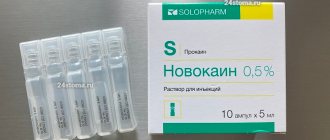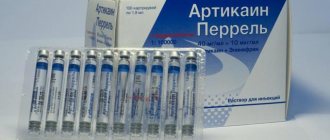From this article you will learn:
- reviews on Ultracain, release forms,
- pros and cons of the drug,
- How much does Ultracaine anesthesia cost?
The article was written by a dental surgeon with more than 19 years of experience.
The anesthetic Ultracaine is a drug in the form of an injection solution that has a very high analgesic effect when administered locally into tissues. The main active component of ultracaine is the substance “articaine hydrochloride” (Articaine), which makes it possible to classify this drug as an anesthetic of the articaine series.
Ultracaine is most often used in dentistry, which is explained by its high efficiency. There are several forms of release of this drug, which differ from each other in the concentration of the vasoconstrictor component that is also included in the composition. The latter is “epinephrine”. This component is added to articaine to locally reduce blood supply in the anesthesia zone, which will reduce the leaching of the anesthetic from the tissues (while increasing the duration and depth of anesthesia).
Anesthetic Ultracaine: photo
For dentistry, the anesthetic is produced not in the form of ordinary injection ampoules, but in the form of special cartridges, which are called carpules (Fig. 2). Such a carpule is inserted inside a special carpule syringe, which has a piston in the form of a handle, and a special double-edged carpule needle is inserted from the side of the syringe nose (Fig. 4). When pressing on the syringe piston, the latter presses on the movable rubber liner inside the carpule, which leads to an increase in pressure inside the carpule and the release of the anesthetic solution through the needle.
Ultracaine release forms –
- ultracaine DS forte (epinephrine concentration 1:100,000),
- ultracaine DS (epinephrine concentration 1:200,000),
- ultracaine D (without epinephrine).
The presence of three forms of drugs is explained by the possible side effects of epinephrine, which can increase the patient's blood pressure. For completely healthy people who do not have cardiovascular or other diseases, Ultracain DS Forte is used. For moderately high blood pressure, Ultracaine DS with a reduced concentration of epinephrine can be used. However, the instructions for use for Ultracain indicate that any of the listed forms can be used from the age of 4 years. We will tell you more about the indications for use of each form below.
How anesthesia is performed in dentistry: video
Ultracaine: price of anesthesia
The cost of 1 carpule of Ultracaine is from 90 rubles (this is the price at which dental clinics purchase it). But in a dental clinic using Ultracain, the price for anesthesia will be approximately 400 to 500 rubles. Unfortunately, you won’t be able to buy a carpule of anesthetic at a pharmacy and bring it with you. This is strictly prohibited by law, because... In this case, the dentist cannot guarantee that the anesthetic is not counterfeit or that it was stored correctly. As a result, the dentist will in any case be to blame for the complications and will be held responsible for it.
Overdose of the drug Ultracain d-s forte, symptoms and treatment
If, during the administration of the drug, initial manifestations of an undesirable effect develop (dizziness, restlessness, stupor), the drug should be stopped and the patient should be placed in a horizontal position. It is necessary to ensure airway patency, monitor heart rate and blood pressure. It is recommended to start IV infusion of crystalloid solutions even if the symptoms do not seem severe, to ensure IV access. For breathing problems, oxygen should be prescribed depending on the severity of the condition; if necessary, perform artificial respiration or tracheal intubation to perform mechanical ventilation. Centrally acting analeptics are contraindicated. Involuntary muscle contractions or generalized convulsions are stopped by intravenous administration of short-acting or ultra-short-acting barbiturates. It is recommended to administer barbiturates slowly, depending on the effect, while continuing oxygen inhalation and cardiac monitoring. The administration of barbiturates should be accompanied by infusional delivery of fluid through a previously installed cannula. For tachycardia and arterial hypotension, it is often sufficient to place the patient in a horizontal position with slightly elevated lower limbs. In case of severe circulatory disorders, including shock, after stopping the administration of the drug, the patient should be in a horizontal position with slightly elevated lower limbs, airway patency, administration of oxygen, intravenous infusion of a balanced electrolyte solution, plasma replacement solutions, albumin, intravenous administration of corticosteroids (for example, 250–1000 mg of methylprednisolone). With a pronounced decrease in blood pressure and bradycardia - intravenous administration of adrenaline: 1 ml of 1:1000 solution is dissolved in 10 ml of solvent and slowly 0.25–1 ml of this solution is administered intravenously (0.025–0.1 ml of adrenaline ). Monitor heart rate and blood pressure. Do not administer more than 1 ml of solution (0.1 mg of adrenaline) at a time. If this dose is insufficient, it is necessary to add adrenaline to the infusion solution (the infusion rate is adjusted taking into account heart rate and blood pressure levels). In case of severe sinus tachycardia or tachyarrhythmia, β-adrenergic receptor blockers are administered intravenously under the control of circulatory parameters. For hypertension (arterial hypertension), peripheral vasodilators are prescribed.
Forms of release of the anesthetic Ultracaine -
Ultracaine: the composition, regardless of the release form, 1 carpool of anesthetic contains 40 mg of articaine, and the volume of anesthetic solution in the carpul will be 1.7 ml. As for the content of epinephrine, as we said above, each of the three forms will have its own concentration of this vasoconstrictor component (vasoconstrictor). It should also be noted that ultracaine anesthetic contains the preservative sodium disulfite, which is designed to stabilize epinephrine in the drug. Moreover, since Ultracain D is produced without epinephrine, it will not contain preservatives.
Ultracaine DS forte (epinephrine 1:100.000) –
An excellent anesthetic for achieving a pronounced and long-lasting analgesic effect during surgical interventions in the oral cavity, for depulping teeth, etc. However, this form cannot be used for high blood pressure, severe cardiovascular diseases, thyroid disease and bronchial asthma.
For detailed instructions from the manufacturer, read: → “Ultracain DS Forte – instructions for use”
Ultracaine DS (epinephrine 1:200.000) –
The best option for use in patients at risk - pregnant and lactating women, patients with compensated cardiovascular diseases. It is undesirable to use for bronchial asthma. Cannot be used for thyroid diseases.
For detailed instructions from the manufacturer, read: → “Ultracain DS – instructions for use”
Ultracaine D (without epinephrine) –
The optimal choice if there is a high risk of allergic reactions, because... This anesthetic is completely free of any preservatives that are necessary to stabilize anesthetics containing adrenaline. In this regard, it is a good choice also for patients with bronchial asthma. Due to the absence of adrenaline, it can be used for diseases of the thyroid gland. The absence of adrenaline allows its use in patients with severe cardiovascular disorders, but it must be taken into account that the duration of action of the anesthetic without epinephrine/adrenaline will be no more than 20 minutes.
For detailed instructions from the manufacturer, read: → “Ultracain D – instructions for use”
Why does anesthesia not go away after dental treatment?
Sometimes the effect of the painkiller lasts longer than expected. The patient can try to reduce the effect of the anesthetic at home. To do this, apply a non-hot compress or massage to the site of anesthesia during the day. This will lead to expansion of the capillaries, which will speed up the removal of active substances from the anesthetized area, and the anesthesia will wear off faster.
In this case, you need to contact your doctor for advice. In addition, these measures are permissible if a filling is placed, but in no case after tooth extraction.
To ensure that the drug does not last longer than necessary, the patient’s liver should not be overloaded, since it is the liver that is responsible for removing the drug from the body. You should also not drink alcoholic beverages immediately after visiting the dentist.
Sometimes anesthesia may not go away due to complications. The main reason for the long-term effects of anesthesia is damage to the nerves of those organs where the zone of anesthesia was located. This may require the help of not only a dentist, but also a neurologist. This occurs both when the pain medication is administered incorrectly, and as a result of the treatment itself.
The prolonged effect of anesthesia should not create panic. The normal duration of anesthesia after injection of an anesthetic into the upper jaw is 2-3 hours, for the lower jaw - 4-5 hours.
If, during these standard dental procedures in the oral cavity, the tooth was anesthetized for a longer period of time, headaches, chills, or general malaise appeared, it is necessary to seek qualified help in a timely manner. The specialist will determine the cause and take measures to ensure that the anesthesia wears off in accordance with the norms.
Sometimes physical therapy may be necessary to eliminate negative symptoms. But cases where anesthesia takes too long to wear off are rare. Also, prolonged exposure to anesthesia is a result of the patient's hypersensitive reaction to the drug.
Ultracain: reviews from dentists
As a practicing physician, I try to use this particular anesthetic primarily, although its cost is 1.5-2 times more expensive than similar anesthetics based on articaine. Thanks to the optimal composition, a minimum of preservatives in the composition (and the complete absence of preservatives in the form of Ultracaine D), this anesthetic can be used in all patients at risk (for cardiovascular, endocrine disorders, allergies, pregnancy and lactation).
Ultracaine reviews from dentists are also as favorable as possible because this anesthetic will be a good choice if you have an allergic reaction to amide group anesthetics, for example Novocaine, Lidocaine and others. But in addition to the high safety profile, this anesthetic is also much stronger than its predecessors (see below). In addition, this anesthetic acts in inflamed tissues, but Novocain practically does not anesthetize in the presence of purulent inflammation.
The duration of action and depth of anesthesia will depend on the concentration of epinephrine in the composition of the product, for example, Ultracaine DS forte 1: 100,000 is the most powerful drug in the line. When conducting conduction anesthesia on the lower jaw, the duration of action averages from 2 to 3 hours. With infiltration anesthesia on the lower and upper jaws - a little more than an hour (24stoma.ru).
Ultracaine or lidocaine: which is better?
- Ultracaine is stronger than Novocaine - 5-6 times,
- more effective than lidocaine - 1.5-2 times.
How long does dental anesthesia wear off?
How long the anesthesia wears off on a tooth during treatment depends on the type of drug used:
- Applied to the surface of the mucous membrane, they act within a few minutes. They are used as a preparatory anesthetic, for example, to reduce pain when an anesthetic is injected into the gum. Comes off quickly;
- When anesthetizing the upper part of the dentition, the drug can act for up to 2.5 hours. How long the anesthesia wears off also depends on the individual characteristics of the patient;
- When intervening in the lower jaw area, stronger anesthesia is required, which takes longer. Therefore, the drug is injected deeper. As a result, the analgesic effect lasts up to four hours. The area of the jaw that needs to be anesthetized also plays a big role.
Only a dentist will tell you exactly how much anesthesia acts on a tooth during treatment; only he knows the dosage and effect of the specific drug that will be used.
The use of painkillers during most dental procedures has long become the norm. General anesthesia, the use of which puts a person into a state of artificial sleep, is rarely used; other methods are usually used. This requires special indications or major surgery.
General anesthesia is indicated in the following cases:
- mental disorders of the patient;
- risk of epileptic seizure;
- pathological fear of dental procedures;
- complexity of the dental procedure.
The scope of application of local anesthesia is much wider. This method is based on the fact that the drugs used block the conduction of nerve endings, thereby relieving the sensation of pain.
Anesthesia has practically replaced the previously used method of providing anesthetic care, based on the use of arsenic to eliminate nerve endings in the dental canal.
What does this depend on?
How long the dental anesthesia takes to wear off depends on the following factors:
- Inflammatory lesions at the injection site. The active elements of painkillers have an alkaline environment, and the localized inflammatory process forms an acidic environment. As a result of their interaction, the alkaline composition of the anesthetic is neutralized, and the anesthesia of the tooth wears off very quickly or does not occur. Therefore, the doctor must carefully calculate the amount of anesthesia, since numbness in such patients goes away much faster.
- The presence in the anesthesia formulation of elements that lead to vasoconstriction. It enhances the effect of the pain reliever. The anesthetic effect occurs later, but at the same time its duration increases, the freezing goes away more slowly.
- Patient's age. The older the patient, the more difficult it is to provide pain relief. At the same time, the process of weakening the anesthetic effect also lasts longer.
- Diseases of the digestive system (diseases of the gastrointestinal tract). Anesthesia is eliminated from the body by the liver and kidneys. Their level of health significantly affects how long tooth frost lasts and how it goes away.
- The duration of the effect of the anesthetic drug depends on the qualifications of the specialist who performed the procedure. If the technique is violated, either prolonged anesthesia or its complete absence occurs; it is very difficult to predict how the anesthesia will wear off.
Ultracaine during pregnancy and breastfeeding
The optimal form of this anesthetic during pregnancy is Ultracaine DS with an epinephrine concentration of 1:200,000. The use of anesthetics without epinephrine (or adrenaline) in pregnant and lactating women is generally not recommended. This is due to the fact that adrenaline, by constricting blood vessels at the injection site, slows down the absorption of the main component (articaine) into the blood, and accordingly this will reduce the peak concentrations of articaine in the blood, and therefore its possible side effects on the fetus.
Ultracaine during breastfeeding - after anesthesia with Ultracaine, the content of articaine in breast milk is possible, but the concentration is so low that it cannot cause any harm. Therefore, there is no need to give up breastfeeding. The epinephrine content in Ultracaine DS is also very small and cannot adversely affect either the mother or the child.
Sources:
1. Higher prof. the author's education in surgical dentistry, 2. Based on personal experience as a dental surgeon, 3. National Library of Medicine (USA), 4. “Local anesthesia in dentistry” (Baart J.), 5. https://dental.sanofi .de/.
Interaction with other drugs
Ultracaine D-S is not recommended for use with cardio-nonselective adrenergic blockers. It is also prohibited to consume alcohol while administering the solution.
Ultracaine is a local anesthetic solution that is mainly used in dentistry.
When performing various interventions, low toxicity and high efficiency allow the anesthetic to be administered to patients without much harm to their body. This article is for informational purposes only, please consult your doctor for details! Ask your doctor about contraindications and side effects.


